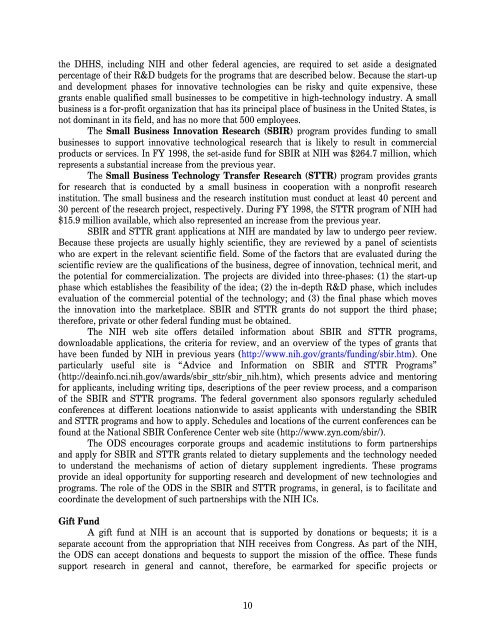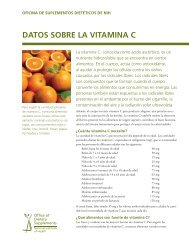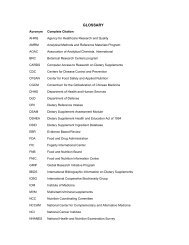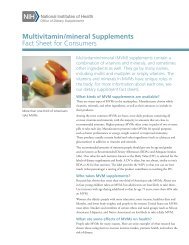status report - Office of Dietary Supplements - National Institutes of ...
status report - Office of Dietary Supplements - National Institutes of ...
status report - Office of Dietary Supplements - National Institutes of ...
Create successful ePaper yourself
Turn your PDF publications into a flip-book with our unique Google optimized e-Paper software.
the DHHS, including NIH and other federal agencies, are required to set aside a designated<br />
percentage <strong>of</strong> their R&D budgets for the programs that are described below. Because the start-up<br />
and development phases for innovative technologies can be risky and quite expensive, these<br />
grants enable qualified small businesses to be competitive in high-technology industry. A small<br />
business is a for-pr<strong>of</strong>it organization that has its principal place <strong>of</strong> business in the United States, is<br />
not dominant in its field, and has no more that 500 employees.<br />
The Small Business Innovation Research (SBIR) program provides funding to small<br />
businesses to support innovative technological research that is likely to result in commercial<br />
products or services. In FY 1998, the set-aside fund for SBIR at NIH was $264.7 million, which<br />
represents a substantial increase from the previous year.<br />
The Small Business Technology Transfer Research (STTR) program provides grants<br />
for research that is conducted by a small business in cooperation with a nonpr<strong>of</strong>it research<br />
institution. The small business and the research institution must conduct at least 40 percent and<br />
30 percent <strong>of</strong> the research project, respectively. During FY 1998, the STTR program <strong>of</strong> NIH had<br />
$15.9 million available, which also represented an increase from the previous year.<br />
SBIR and STTR grant applications at NIH are mandated by law to undergo peer review.<br />
Because these projects are usually highly scientific, they are reviewed by a panel <strong>of</strong> scientists<br />
who are expert in the relevant scientific field. Some <strong>of</strong> the factors that are evaluated during the<br />
scientific review are the qualifications <strong>of</strong> the business, degree <strong>of</strong> innovation, technical merit, and<br />
the potential for commercialization. The projects are divided into three-phases: (1) the start-up<br />
phase which establishes the feasibility <strong>of</strong> the idea; (2) the in-depth R&D phase, which includes<br />
evaluation <strong>of</strong> the commercial potential <strong>of</strong> the technology; and (3) the final phase which moves<br />
the innovation into the marketplace. SBIR and STTR grants do not support the third phase;<br />
therefore, private or other federal funding must be obtained.<br />
The NIH web site <strong>of</strong>fers detailed information about SBIR and STTR programs,<br />
downloadable applications, the criteria for review, and an overview <strong>of</strong> the types <strong>of</strong> grants that<br />
have been funded by NIH in previous years (http://www.nih.gov/grants/funding/sbir.htm). One<br />
particularly useful site is “Advice and Information on SBIR and STTR Programs”<br />
(http://deainfo.nci.nih.gov/awards/sbir_sttr/sbir_nih.htm), which presents advice and mentoring<br />
for applicants, including writing tips, descriptions <strong>of</strong> the peer review process, and a comparison<br />
<strong>of</strong> the SBIR and STTR programs. The federal government also sponsors regularly scheduled<br />
conferences at different locations nationwide to assist applicants with understanding the SBIR<br />
and STTR programs and how to apply. Schedules and locations <strong>of</strong> the current conferences can be<br />
found at the <strong>National</strong> SBIR Conference Center web site (http://www.zyn.com/sbir/).<br />
The ODS encourages corporate groups and academic institutions to form partnerships<br />
and apply for SBIR and STTR grants related to dietary supplements and the technology needed<br />
to understand the mechanisms <strong>of</strong> action <strong>of</strong> dietary supplement ingredients. These programs<br />
provide an ideal opportunity for supporting research and development <strong>of</strong> new technologies and<br />
programs. The role <strong>of</strong> the ODS in the SBIR and STTR programs, in general, is to facilitate and<br />
coordinate the development <strong>of</strong> such partnerships with the NIH ICs.<br />
Gift Fund<br />
A gift fund at NIH is an account that is supported by donations or bequests; it is a<br />
separate account from the appropriation that NIH receives from Congress. As part <strong>of</strong> the NIH,<br />
the ODS can accept donations and bequests to support the mission <strong>of</strong> the <strong>of</strong>fice. These funds<br />
support research in general and cannot, therefore, be earmarked for specific projects or<br />
10
















